
From the CEO: What Keeps Us Going
December 01, 2025
Written By Alyson R. Kuroski-Mazzei, DO, DFAPA, FASAM - CEO & Chief Medical Officer Reflecting on Another Year at HopeWay As we close out another year at HopeWay, I find myself reflecting on what sustains me in this work....

Story of Hope: Meet Jennifer
December 01, 2025
Life Before HopeWay Like so many others who walk across that bridge, I was at one of the lowest points in my life when I came to HopeWay. I had recently been diagnosed with bipolar...
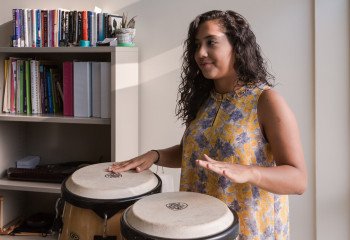
Feeling the Rhythm
December 01, 2025
Written by JD McNutt, Pastoral Care Coordinator and Drum Circle Facilitator The Ancient Power of Healing Rhythms Long before modern medicine, cultures around the world used rhythm as a form of healing. Today, science is catching...

Societal Pressures and Eating Disorders
December 01, 2025
Written by Andrew Harris, MS, LCMHC Clinical Director - Center for Eating Disorders The Definition of Eating Disorder Eating disorders are serious and complex mental health conditions characterized by persistent disturbances in eating behaviors, thoughts,...

Navigating Holiday Meals with a Loved One in Eating Disorder Treatment
November 21, 2025
For many, holiday meals are centered around gratitude and togetherness. For someone navigating an eating disorder or disordered eating recovery, it can also bring extreme stress and anxiety. If you’re spending the holidays with a...

Understanding Veteran Culture to Provide Effective Treatment
November 04, 2025
Written by Ross Cole, LCSW, Primary Therapist - Veterans Program What is Veteran Culture? In 2018, while completing his psychiatry residency, Dr. Gregory Burek authored an article on Veteran culture that was published in the Resident’s Journal...

Andrew's Story - Compassion
November 01, 2025
I had my first experience with depression and anxiety in high school. Back then, it felt manageable - something I could navigate with the help of my parents. But when I got to college, pieces...

Beth's Story - Trust
November 01, 2025
Like most people, I came to HopeWay during an extremely difficult time in my life. I was in the midst of a mental health crisis, and knew I needed intense and immediate help. I found...

Dr. Taren Coley - Excellence
November 01, 2025
When we talk about HopeWay’s core values, excellence isn’t just a word on the wall. It’s a practice we live every day. It shows up in our program design, clinical care, staff training, and the courage...
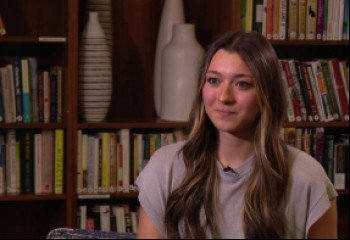
The Tanner's Story - Hope
November 01, 2025
Like many families, we’ve learned that mental health struggles are more common than not. In that way, our story isn’t unique. However, we’ve also seen that most families choose not to share their experiences, and...

Understanding The Teenage Brain
October 17, 2025
You often hear that adolescence is one of the biggest times for change. Teens are going through puberty, growth spurts, navigating relationships and new responsibilities. In addition to the physical, social and emotional changes, their...
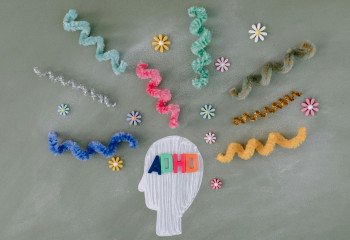
Understanding ADHD
October 01, 2025
Written by Erin Dos Reis, LCSW, Clinical Director at HopeWay’s Teen Mental Health Programs Attention-Deficit/Hyperactivity Disorder (ADHD) is one of the most common neurodevelopmental disorders, yet it is also one of the most misunderstood. Parents,...
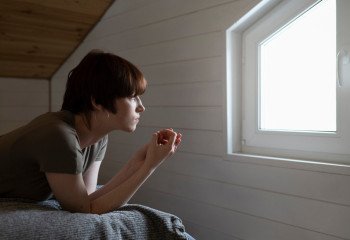
Understanding Light Therapy: A Bright Approach to Depression
September 24, 2025
Written by Kevin Marra, MD, Director of Medical Services The Benefits of Sun for Mental Health Sunlight plays a critical role in regulating our mood and mental health by helping the brain produce serotonin, a...

New at HopeWay: Drama Therapy
September 23, 2025
Written by Jessica Bilgrad, RDT, Integrative Specialist What is Drama Therapy? Drama Therapy uses creativity and roleplay to help clients tell their stories, express emotions, and explore personal challenges in a safe and supportive environment....

Story of Hope: Meet Rachel
September 23, 2025
Life Before HopeWay I came to HopeWay during one of the hardest seasons of my life. About a year before arriving, I slipped into a depressive episode so deep I couldn’t pull myself out. Weekly...

From the CEO: 2024 Outcomes Data
September 23, 2025
Written By Dr. Alyson R. Kuroski-Mazzei, DO, DFAPA, FASAM - CEO & Chief Medical Officer At HopeWay, we believe that mental health treatment should be grounded in evidence, compassion, and measurable progress. That’s why every year we publish our...
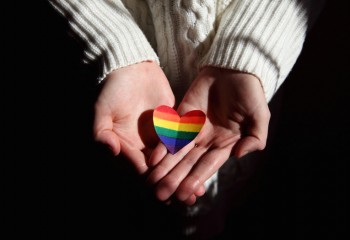
LGBTQIA+ Mental Health Care & Community Resources
September 23, 2025
Sheri Tiziani, LCMHCS, Primary Therapist Ren Brown (they/she), LPC, LCMHCA, CCTP, ISTT, EMDR-Trained Primary Therapist Welcoming Pride Month 2025 As we enter Pride Month, we believe it will be helpful to highlight some of...

National Suicide Prevention Month & Signs of Suicide
September 18, 2025
Written by Tom Gettelman, PhD, Former Chief Clinical Officer at HopeWay Stigma Around Suicide Suicide. Admittedly, this is a hard, uncomfortable and sensitive subject to approach in conversation. There is still quite a bit of stigma and shame...

Helping Your Child Adjust to a New School
August 20, 2025
Maggie Dye, Lead Education Specialist Navigating Back-to-School Transitions and Emotions It’s common for back-to-school season to bring a mix of excitement and nerves, but for children starting at a new school, these emotions can feel...

Meditation for Kids: A Mindful Practice for the Whole Family
August 18, 2025
Victoria Brewer, MA, NCC, LCMHC When you picture meditation, you might imagine someone sitting cross-legged in silence for long stretches of time. But for children, especially those experiencing anxiety, emotional dysregulation, or sensory overload, meditation...
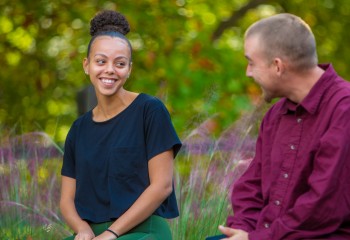
What is DBT (Dialectical Behavior Therapy)?
August 14, 2025
Sheri Tiziani, LCMHCS, Primary Therapist DBT is a type of Cognitive Behavioral Therapy that was developed to help clients cope with, and change, unhealthy behaviors while focusing on four areas – mindfulness, distress tolerance, emotional...
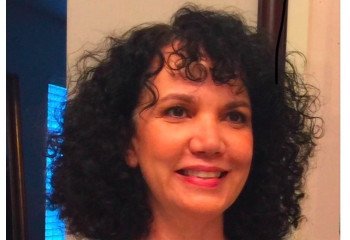
Story of Hope: Meet Mercy
June 30, 2025
Life Before HopeWay I came to HopeWay feeling like I had lost all hope. I had tried everything including therapy and lifestyle changes, but nothing seemed to make a lasting difference. I felt like I...

Rooted in Resilience
June 30, 2025
Written By Bobbie Mabe, MA, Horticultural Therapist Horticultural Therapy at HopeWay Weeding isn’t typically the highlight of gardening. It’s repetitive, challenging, and not always glamorous. However, in the HopeWay garden, this humble task often becomes...

From the CEO: 9 Questions for 9 Years
June 30, 2025
Written By Dr. Alyson R. Kuroski-Mazzei, DO, DFAPA, FASAM - CEO & Chief Medical Officer As I celebrate my 9th anniversary with HopeWay, I was asked to answer nine questions about the journey - where we started, what...

Summer Break Mental Health Tips for Students
May 21, 2025
Blake Ravin, LCMHC, Primary Therapist – Teen Mental Health Program Why Summer Affects Student Mental Health Summer is often a time of relaxation and enjoyment for students, but it's important to remember that mental health...

How to Manage Stress During Finals
May 06, 2025
Lucy Falls, MPH, RD, LDN Registered Dietician - Health & Wellness Specialist Why is Finals Week So Stressful? Longer days, warmer temperatures and more things on the calendar means springtime is ramping up. This can...
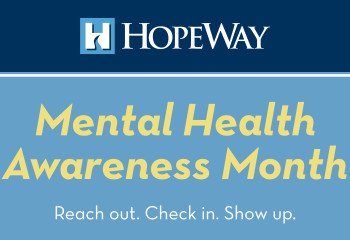
Mental Health Awareness Toolbox
April 30, 2025
Mental Health Awareness Month is a time to support one another, reduce stigma, and take simple but powerful steps to improve mental health. Reach out. Check in. Show up. We’ve curated a digital toolbox filled...

Mental Health Awareness Month - How to Support a Loved One
April 29, 2025
Written by Alyson Kuroski-Mazzei, DO, DFAPA, FASAM CEO & Chief Medical Officer Mental illness impacts millions of Americans each year. During Mental Health Awareness Month in May, we are offering helpful tips on how to support...

Carbs & Anxiety: How Can Carbs Affect Your Mental Health?
March 25, 2025
Written by Sarah Craig Haverland, MS, RD, LDN Health & Wellness Specialist and Ellen Jones, MS, RD, LDN, Health & Wellness Specialist Carbs and the Brain When a new season approaches, many of us enjoy pursuing the...

Nourishing the Mind: The Critical Link Between Nutrition and Mental Health
March 24, 2025
By Alyson R. Kuroski-Mazzei, DO, DFAPA, FASAM CEO & Chief Medical Officer at HopeWay The Importance of Nutrition When we think about food, we often focus on its role in maintaining physical health: supporting heart...

From the CEO: Inclusion
March 21, 2025
By Alyson Kuroski-Mazzei, DO, DFAPA, FASAM CEO & Chief Medical Officer HopeWay's Commitment to Inclusion As we move forward in 2025, I want to take a moment to reaffirm HopeWay's steadfast commitment to fostering an...
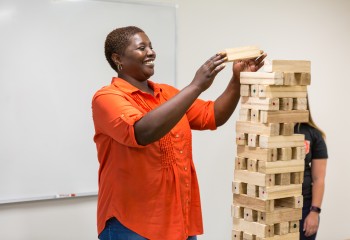
The Power of Play
March 20, 2025
Written by Diana Richards, LRT/CTRS, Recreational Therapist and Emily Disney, MS/LRT/CTRS, Recreational Therapist What is Recreational Therapy? Some people think recreational therapy (rec therapy) is just about physical activity or playing games. While these elements are certainly...

Story of Hope: Meet Eric
March 01, 2025
Taking the First Step Writing poetry. Drawing. Sharing my inner thoughts with others. Being vulnerable. All of these concepts were foreign to me before entering HopeWay in 2024. Now, as I share my story, I...

National Eating Disorder Awareness Week
February 25, 2025
Eating Disorder Stereotypes What do you think of when you hear the phrase "eating disorder"? There are many societal stereotypes that surround these specific diagnoses. Common Misconceptions Eating disorders are a rich, female Caucasian problem;...

The Importance of Sleep for Mental Health
February 21, 2025
Everyone Does It. Everyone Needs It. But Not Enough of Us Get It. Sleep. Written by Justin Johnson, MD, DFAPA, Psychiatrist - Director of Veteran & First Responder Services Recommended Hours of Sleep Despite the importance of...
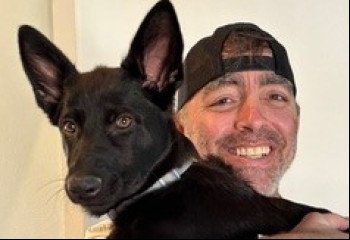
A Journey Through Hell and Back
January 21, 2025
Danny, Former HopeWay Client Life Before HopeWay I can remember growing up as a happy-go-lucky child. As I became a teenager, I noticed periods when I would feel down, but I was able to bounce...
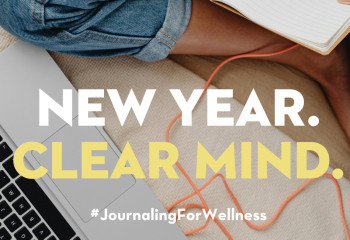
New Year. Clear Mind.
January 01, 2025
Journaling for Wellness It’s the new year - a fresh start and a clean page. Throughout January, we invite you to join us in Journaling For Wellness. We have written a daily journal prompt designed to...
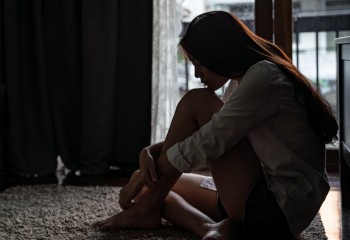
Radical Acceptance in a Time of Uncertainty
December 19, 2024
Written by Andrew Harris, MS, LCMHC, Primary Therapist & Clinical Director - Center for Eating Disorders DBT and Radical Acceptance In times of uncertainty, it is both understandable and valid to feel anxious. Navigating unfamiliar situations...

Self-Care in the New Year
December 17, 2024
Alyson Kuroski-Mazzei, DO, DFAPA, FASAM CEO & Chief Medical Officer Last week, someone asked me about my self-care routine. I hesitated–yoga? It felt more like an aspiration than an answer. It reminded me of an...

Gratitude is More Than Just Saying "Thank You"
December 17, 2024
John Conway, LCSWA - Primary Therapist What is Gratitude? Gratitude is a mindset that involves recognizing and appreciating the good in life, no matter how small. This simple practice can transform your outlook, improve your...

Understanding and Overcoming Social Anxiety
December 17, 2024
Mollie Sandler, LCSW - Primary Therapist Social Anxiety During the Holidays As we navigate through the holiday season, we may find our calendars full of social engagements, celebrations, and parties. Gatherings with family, friends, and...

Journaling for Mental Health
December 13, 2024
Kaitlin Wightman-Ausman, MT-BC, Music Therapist Writing as Therapy with a Mental Health Journal Writing has been around for thousands of years and is typically a skill we learn at a young age. We often associate...

Productive Leisure Activities - Oxymoron or Effective Therapy?
November 20, 2024
Written by Leigh Spada, LRT/CTRS, Recreational Therapist What are Leisure Activities or Productive Leisure Time? When you hear the term "leisure time" and “productive leisure” – what comes to mind? Do you think of tasks like mowing...

Determined to Heal
November 07, 2024
One of my favorite HopeWay therapists told me, “Everything works until it doesn’t.” And that’s exactly what happened to me. I was one of those high-achieving, “jack-of-all-trades” types of people who took every traumatic experience...

Breathe Deep With Pranayama
September 30, 2024
Genevieve Scott, MT-BC, RYT Music Therapist The Therapeutic Benefits of Breathwork During Yoga Yoga classes at HopeWay often begin and end with pranayama, or breathwork. During pranayama, clients are guided to focus on their breath, practice techniques...

Lessons From the Field
September 30, 2024
Austin Sowell, MSN, APRN, PMHNP-BC Nurse Practitioner - Eating Disorders Student Athlete Mental Health Over the past several years, there has been significant attention on the mental well-being of athletes, particularly college athletes. With all the...
_th.jpg)
Being a Non-Profit Matters
September 30, 2024
Written by Alyson Kuroski-Mazzei, DO, DFAPA, FASAM, CEO & Chief Medical Officer Primum Non Nocere (First Do No Harm) As a physician executive, reading the recent New York Times article “How a Leading Chain of...

Difference Between Inpatient and Residential Mental Health Treatment
August 20, 2024
Written by Tom Gettelman, PhD, Chief Clinical Officer & Director of Admissions What is the Difference Between Inpatient and Residential Treatment? Acute Inpatient Hospitalization A person is actively suicidal or homicidal or their psychiatric symptoms are...

The Healing Power of Stories - Meet Megan
June 26, 2024
Life Prior to HopeWay I’d heard stories about people overcoming mental health struggles before, but I never believed one of those stories could be me. My experience felt different. Like I was the only one...

Understanding Obsessive-Compulsive Disorder: myths, realities, and treatment
June 26, 2024
Written by Kevin Marra, MD Director of Medical Services In my experience as a psychiatrist, I've frequently noticed that conversations surrounding Obsessive-Compulsive Disorder (OCD) tend to stir up a mix of misconceptions and uncertainties. In...
_th.jpg)
Healing Together: Benefits of Group Therapy
April 11, 2024
Written by Blake Ravin, LCMHC Primary Therapist - Teen Program Participating in group therapy offers a unique and positive impact that is difficult to replicate in a 1:1 session. If you’re thinking “what are the...

A Story of Hope: A Healing Community
March 26, 2024
HopeWay Alumni Support When I received an email about the new ‘Alumni Garden Club’ at HopeWay, I immediately texted my friends from treatment to sign up with me. Going back to HopeWay is more than...

Managing Mealtimes
March 26, 2024
Sarah Craig Haverland, MS, RD, LDN, Health & Wellness Specialist and Kristen Shaben, MS, RD, LDN, NBC-HWC, RYT Health & Wellness Specialist Meal planning often feels like an additional burden in our already busy lives, causing...

Post Traumatic Growth: From Darkness to Light, From Trauma to Growth
March 26, 2024
Marianne Huebner, MS-ATR, Art Therapist The most dangerous time for a bird to be alive is at night. The darkest hours become the most vulnerable because that is when predators (snakes, raccoons, opossums, and cats)...

Navigating Recovery: HopeWay’s New Eating Disorder Programs
March 14, 2024
We are excited to introduce two new eating disorder programs to our list of services and programs. These programs include an adolescent track tailored for individuals ages 12 to 17 and a young adult track...

Grounding: 5-Step Technique to a Relaxed Body & Mind
February 21, 2024
Grounding Technique The idea of being grounded is really just about being connected to the present moment and this technique is a great tool to use when feeling anxious or overwhelmed. If you were asked...

Metta Meditation: Learn to Love Yourself & Those Around You
February 21, 2024
Participate at home in a metta meditation with our meditation practitioner. In the busy world we live in, finding time to unplug from the world and look inward can seem like an impossible task. Amongst...

Standing in the Rain: Visualizing Mindful Meditation
February 21, 2024
Participate in this guided meditation that combines mindfulness and art therapy to help center your thoughts. On a daily basis, we are bombarded with responsibilities, tasks, and burdens that can put a damper on our emotional...

Don't Should Yourself
December 11, 2023
Erin Dos Reis, LCSW Clinical Director, Teen Mental Health Programs Holiday Pressure The holidays seem to come around faster and faster every year. This might be because there are Halloween decorations out during the summer...

Supporting Youth Mental Health
October 05, 2023
HopeWay Covington Event On September 13th in a crowded theater at CPCC, Dr. Harold Koplewicz joined Dr. Kuroski-Mazzei for a conversation on the current state of adolescent mental health. While this topic can be overwhelming...

A Different Kind of Prescription for Depression: Strength Training
September 28, 2023
Angela Fedchenko, MD, PMH-C, Psychiatrist - Medical Director of Admissions & Women's Psychiatry The Impact of Exercise on Mental Health “How often are you able to exercise?” The psychiatrists typically ask this question during a...

3 Takeaways From a (Two-Time) HopeWay Alumna
September 28, 2023
My Journey With HopeWay Before I dive in, let me share a bit about my story with you. On paper, my life was incredible, but the truth was, just existing felt unbearable. I couldn’t make...
 (350 × 240 px)_th.jpg)
The Essence of Resilience
September 28, 2023
Sheri Tiziani, MS, LCMHCS, Primary Therapist What Does it Mean to be Resilient? “We must free ourselves of the hope that the sea will ever rest. We must learn to sail in high winds”. - Aristotle...

7 Ways to Empower Your Child to Embrace Change
August 29, 2023
Taren Coley, Director of Child & Adolescent Services Article previously written for QCity Metro The Impact of Change on Teens and Adolescents Change can be difficult, regardless of age, and often accompanied by fear of the...
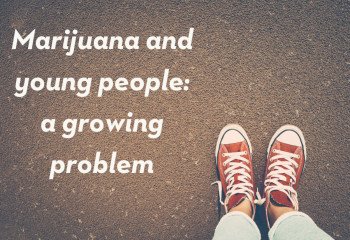
Marijuana and Young People: A Growing Problem
June 27, 2023
Alan Bozman, PhD Director of Clinical Services Many Baby Boomers, Generation X and even Millennials grew up with the notion that cannabis is a relatively harmless substance. When some parents discover their child is experimenting...

Self-Worth: A Cornerstone of Mental Health
June 21, 2023
Written by Ama Owusuaa, MEd, LCMHC-S, NCC, Primary Therapist Self-Worth vs. Self-Esteem In HopeWay’s self-awareness therapy group, we talk about the terms “self-worth” and “self-esteem” which are often confused. These two words are not synonymous,...

Minding Your Mental Health Challenge - MHA Month
April 26, 2023
Mental Health Awareness Month is a month dedicated to increasing awareness and education about mental health, the realities of living with a mental illness, and strategies to live mentally well. Throughout the month of May, we...
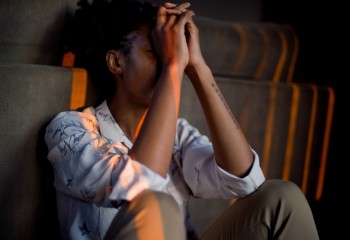
Self-Care Tips for Stress Awareness Month
April 20, 2023
Erin Dos Reis, LCSW, Primary Therapist What is Chronic Stress Chronic stress can cause depression, anxiety, insomnia, headaches and other symptoms that affect our health. During Stress Awareness Month, which was created in 1992 to...
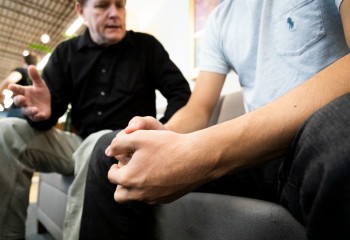
What is Bipolar Disorder?
March 13, 2023
Kristi Wragg, MD, MSW, Director of Outpatient Services Bipolar disorder is more than mood swings: understanding accurate diagnostic terminology Bipolar Disorder Stigma Mental health diagnostic terminology is often used in everyday conversation, and commonly, the...
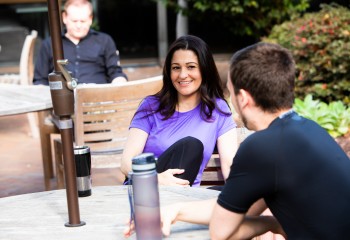
The Benefits of Blessing Others
November 30, 2022
Written by JD McNutt, Pastoral Care Coordinator Giving Back Three years ago I was in Costa Rica on a mission trip, and each afternoon our group gathered together food items – powdered milk, corn meal,...
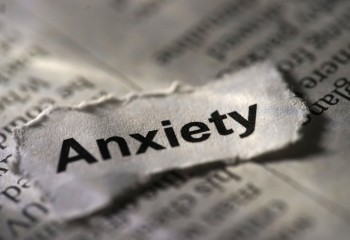
Regaining Control Over Anxiety
November 30, 2022
Written by Alan Bozman, PhD, Director of Clinical Services Anxiety Around the Holidays We all experience anxiety and, for many, the holidays can exacerbate feelings of anxiousness. To understand how anxiety can become problematic, you...
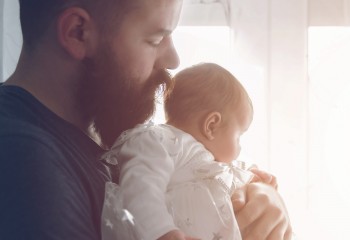
Postpartum Depression Impacts Everyone, Not Just Mothers
September 07, 2022
Angela Fedchenko, MD, Medical Director of Admissions & Women's Psychiatry PPD Postpartum Depression (PPD) has been increasingly studied, and new treatments have been developed in recent years. However, it still remains stigmatized and under-recognized given...
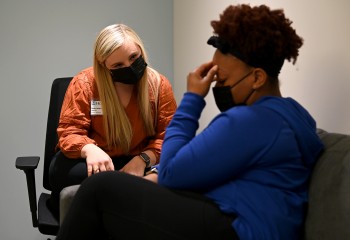
Behavioral Health vs Mental Health
June 09, 2022
Written by Tom Gettelman, PhD, Chief Clinical Officer Oftentimes “mental health” and “behavioral health” are used to mean the same thing. But is it accurate to do so? The terms “mental health” and “behavioral health”...
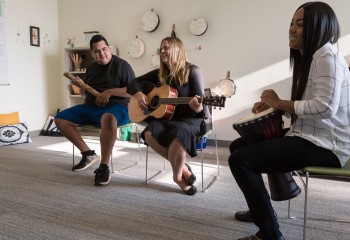
Tuning Into Music for Mental Health
June 09, 2022
Written by Joan Kleinmann, MT-BC, LRT/CTRS Music and Emotions Have you ever been brought to tears by a song? Or heard a song on the radio that made a memory so intense it was like...

The Effects of Social Isolation on Mental Health
February 21, 2022
Loneliness Caused by Social Interaction Over the past two years, people have become increasingly disconnected from one another. We have had to “shelter in place” and “socially distance” in order to keep ourselves physically safe....

Orthorexia Nervosa: When Healthful Eating Becomes Harmful
February 21, 2022
Written by Greer Mitchell, JD, MD, Director of HopeWay's Center for Eating Disorders The Problem With Perfection In January, many people pledged to do less of this thing and more of that, hoping to end old...

Your Questions Have Been Answered
February 16, 2022
Finding the right mental health treatment can be complicated, and if you or a loved one is suffering, the process can be emotional and overwhelming too. Whether you are trying to find treatment for yourself...

Putting Thoughts On Trial
January 20, 2022
By Erin Dos Reis, LCSW, Primary Therapist Cognitive Distortions THIS IS GOING TO LAST FOREVER. That type of thinking is easy to get sucked into right now. Even the line at the grocery store feels...
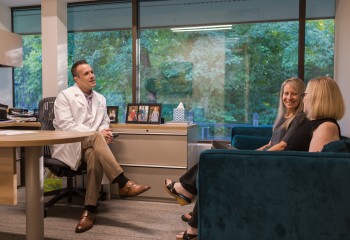
Psychiatric Medication Management For Mental Health
January 20, 2022
Written by Dr. Kevin Marra, MD, Psychiatrist - Director of Medical Services Common Concerns “Do I have to take medicine as part of my treatment?” “I’m hesitant to go on medication because I don’t want...

A Story of Hope: Meet Elizabeth
December 21, 2021
Before HopeWay Growing up, I always made excuses for things that went wrong in my life. I struggled to take responsibility for my wrongdoings, and I refused to admit I needed help. In June 2020,...
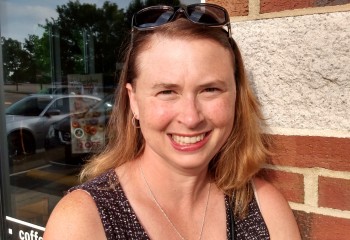
A Story of Hope: Meet Nicole
December 20, 2021
Journey to HopeWay Hi, my name is Nicole and I'm one of the millions of people who suffer from mental illness. My journey with severe depression began with the birth of my first child. Pregnancy...

5 Years Strong
November 30, 2021
Over the past five years, we have seen firsthand the ripple effect of HOPE. It can start small, maybe even with one person and then it grows and spreads. HOPE becomes an unstoppable force propelling people...
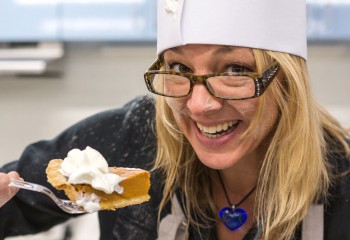
7 Ways to Practice Self-Care During the Holidays
November 22, 2021
By Marianne Huebner, MS-ATR, Art Therapist “We must have pie. Stress cannot exist in the presence of pie.” - David Mamet Each year, after the celebration of haunts and spirits, we begin to prepare for...
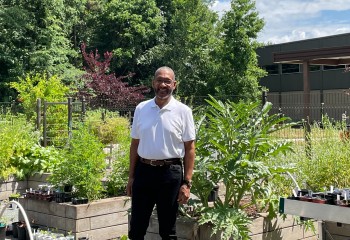
A Story of Hope: Meet Tim
October 05, 2021
HopeWay gave me a different outlook on life. Just like the name says, I found hope. I’m a Veteran and spent 30 years in the Marine Corps. I grew up in a working class family...

A Story of Hope: Meet Tracy
October 05, 2021
For the past 26 years, I believed that I was responsible for the trauma that happened in my life. I carried that weight around every single day and never thought anyone would ever understand. My...
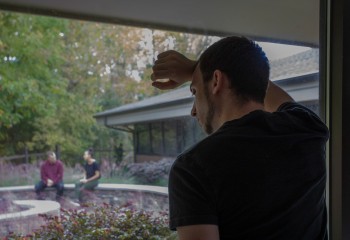
The Impact of Big T and little t Trauma
October 05, 2021
Written by Kevin Marra, MD, Director of Medical Services Trauma can describe a certain stressful or disturbing event. Trauma can also describe the effect such an event has on a person’s physical and emotional health. Big...
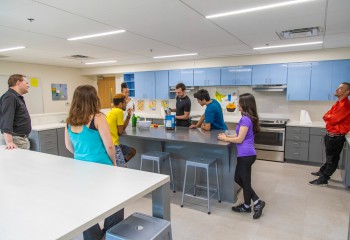
Food for Thought
October 05, 2021
By Ellen Jones, RD, LDN, Registered Dietician, Health & Wellness Specialist In the Learning Kitchen at HopeWay, the Health & Wellness Specialists help clients understand the connection between their brain and their gut, their emotions...

Minority Mental Health Month
July 01, 2021
Lynn Conner, LCSW, Primary Therapist Over the past year and half, we have experienced a global pandemic, state shut-downs and social unrest. The nation collectively grieved and continues to grieve lives lost to violence and...
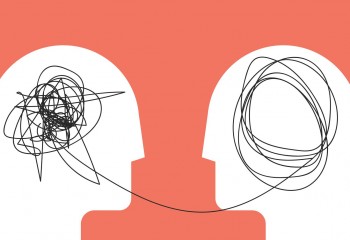
EMDR Therapy
July 01, 2021
Written by Ross Cole, LCSW, Veterans Program - Primary Therapist PTSD Treatment Programs One of the differentiators of HopeWay’s Veterans Program is that we offer all three of the most evidence-based and highly-recommended treatments for PTSD:...

Beet Pesto Recipe to Support Mental Wellness
June 28, 2021
Beet pesto is always a hit in the Learning Kitchen! This alternative to basil pesto not only tastes delicious but also provides significant health benefits. The pigment that gives beets their deep pink color is...

A Story of Hope: Meet Kate
June 28, 2021
I walked through the doors of HopeWay as a depressed, co-dependent person with no self-esteem. After six weeks of treatment, I left HopeWay strong, confident and comfortable in my own skin. It did not happen...

Planting Hope with a Container Garden
June 28, 2021
Bobbie Mabe - Horticultural Therapist Gardening and Mental Health It is that time of year when people start freshening up their outdoor planters and working on their gardens, but did you know that these simple...

Shining a light on societal mental health and the future
April 12, 2021
Alyson Kuroski-Mazzei, DO, DFAPA, FASAM | CEO & Chief Medical Officer You’ve seen the headlines. We are seeing mental health challenges surge as we continue to navigate the pandemic, and socioeconomic determinants of health continue to go...
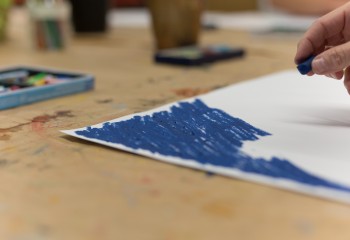
The Benefits of Art Therapy: Creativity, Imagination & Well-being
April 12, 2021
Marianne Huebner, MS-ATR, Art Therapist Get out your glue gun and popsicle sticks; we are going to tackle mental wellness in a way you...
.JPG_th.jpg)
A Story of Hope: Meet Sherry
April 01, 2021
“HopeWay saved my life, literally saved me from myself.” I was at the lowest point in my life. Things had gotten so bad that I was having suicidal thoughts, which landed me in the hospital....

Ways to Combat Holiday Stress Related to COVID-19
December 01, 2020
Allison Todd, LCSW, Primary Therapist As we approach the holiday season, it is fair to experience a multitude of emotions related to this time of year, especially now that we are in the midst of...

HopeWay's Fourth Anniversary
November 30, 2020
Today marks HopeWay’s fourth anniversary! The facility welcomed its first client on Nov. 30, 2016 and has served more than 1,500 clients from 31 states and 2 other countries to date. The following are some...

Psychotherapy: A Personal Trainer for the Soul
October 01, 2020
Written by Justin Johnson, MD, DFAPA, Director of Veteran & First Responder Services What is Psychotherapy? Psychotherapy, broadly defined, is an “interpersonal treatment based on psychological principles” (UpToDate, 2019). During psychotherapy, mental health-related change occurs in the...
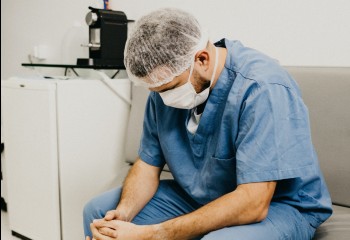
Sometimes Heroes Need Saving Too: Physician Mental Health
August 03, 2020
Written by Kevin Marra, MD, Director of Medical Services Physicians. Our healthcare heroes. They have always been known for saving people’s lives but now they are risking their own lives to save others in light of...

A Story of Hope: Meet Katie
June 01, 2020
HopeWay not only changed the way I live my life, but it also saved my life. I will never be able to adequately express my gratitude, but I will do my best to provide hope...
_th.jpg)
Surviving to Thriving with Meditation
May 04, 2020
By Marianne Huebner, MS-ATR, HopeWay Art Therapist In the assumed quietude of being “safe at home”, the “shoulds” have poked the exiled ethos, telling us we aren’t doing enough, learning enough, succeeding enough, or focused...

#stayhomestayhopeful - Talking to Children about the Coronavirus
April 20, 2020
Written by Taren Coley, MD, Psychiatrist As we are all tasked with figuring out our “new normal” in times like these, many adults are also dealing with finding ways to talk with children about the...

#stayhomestayhopeful - A Reflection: Adapting To A New Normal
April 14, 2020
By Judy Champagne, RN, Wellness Clinic Nurse One of my early memories is playing tag in the front yard. I turned my back and thought I would not be found. News flash: I was easily...

#stayhomestayhopeful - At Home Leisure Activities
April 14, 2020
By Leigh Giacometti, LRT/ CTRS, Recreational Therapist During this time of social distancing and quarantine it is important to remember to engage in healthy leisure activities. It is easy to get sucked into Netflix, TV,...

#stayhomestayhopeful - Values
April 10, 2020
By Alan Bozman, PhD, Director of Clinical Services In times like these, it’s grounding to consider your values. Upon reading that sentence, you may think, "Why do I need to spend time thinking about my...

Best Ways To Practice Self-Care - #stayhomestayhopeful
April 10, 2020
By Saidat Kashimawo-Akande, MD During these unprecedented times in which we are being asked to shelter at home, be it alone or with others in the “family unit,” it can feel both daunting and unsettling....
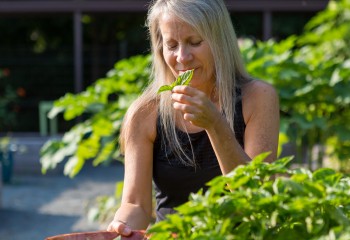
#stayhomestayhopeful - Connecting with Nature
April 07, 2020
By Bobbie Mabe, Horticultural Therapist Social distancing has become a part of our daily vocabulary. We are forced to isolate from one another in a time when we need true connection. But even during this...
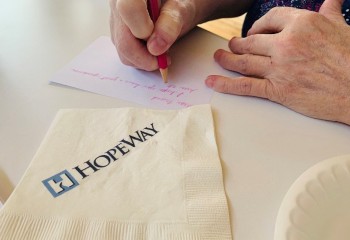
Music & Writing When Times Feel Heavy
April 07, 2020
By Joan Kleinmann, MT-BC, LRT/CTRS, Music Therapist Ever since I was a young child, I can remember writing down my thoughts and feelings. I kept different journals for different occasions. One for travel, one for song lyrics,...
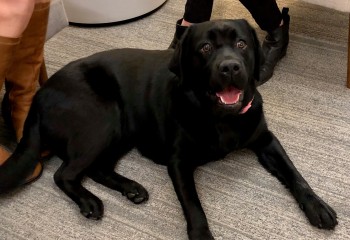
#stayhomestayhopeful - The Benefits Of Time With Our Furry Friends
April 07, 2020
By Allison Todd, LCSW, Primary Therapist In times of stress and uncertainty, we look for things that provide us comfort and stability. For some, that may be talking to friends and loved ones, taking a...

#stayhomestayhopeful - Gratitude.
April 07, 2020
By Sheri Tiziani, MS, LPC, Primary Therapist Gratitude is a practice that we can all benefit from greatly in our daily lives. It has a tremendous impact on our mental health and overall well-being. Studies...
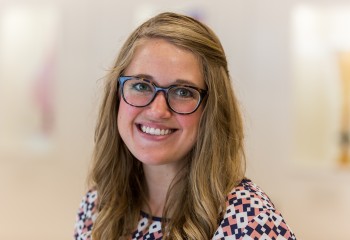
#stayhomestayhopeful - 10 Tips for Coping with Social Distancing
April 01, 2020
Written by Corey Connelly, MA, LPC, LCAS, HopeWay Primary Therapist Right now we’re living in an unprecedented, scary, and isolating time. Even though this is very difficult, and there are a lot of things we...
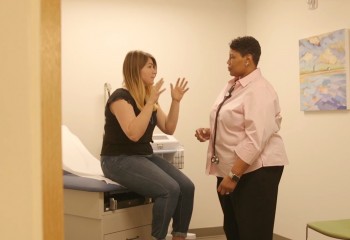
Why Integrative Medicine Works
February 03, 2020
Saidat Kashimawo-Akande, MD Staff Psychiatrist In recent years there has been a recognizable shift in medical care that focuses more on the entire individual rather than one specific symptom or concern. The pendulum is...
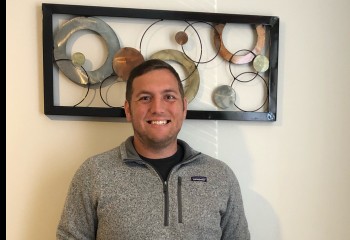
A Story of Hope: Meet Brady, Three Years Later
November 26, 2019
November 30, 2019 marked 3 years since HopeWay welcomed its first client. To celebrate this anniversary, we decided to check in with Brady Smith, who came to HopeWay in that first month in 2016 as...

A Story of Hope: Meet Latimer
November 01, 2019
On November 6, 2018, I walked through the doors of HopeWay a broken man that wanted to get well. Yet, I felt that I did not deserve the wellness I sought. For years, I had...

Faces of Hope: Andrew Harris, MS, LCMHC
September 10, 2019
When a client admits to HopeWay, the members of their treatment team are dedicated to equipping the client with the resources they need to achieve their clinical goals. Primary Therapists are integral members of this...
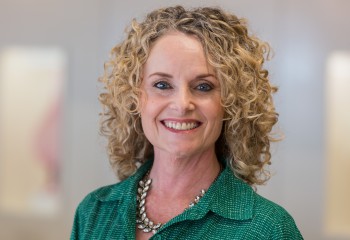
Faces of Hope: Karen Ortiz, Outreach Specialist
August 13, 2019
Karen Ortiz is a member of HopeWay's dedicated team of Outreach Specialists who meet and build relationships with service providers, including hospitals, outpatient therapists, education consultants, and other specialty doctors, in a multi-layered effort to...

A Story of Hope: Meet Amanda
August 01, 2019
HopeWay. To many, this word doesn’t hold any significance. In fact, some don’t even know that it’s not just a word, but a place. Though housed in Charlotte, NC, HopeWay is a safe, nurturing sanctuary...

Faces of Hope: Carmella Aldridge, MA Client Care Coordinator
July 23, 2019
HopeWay's dedication to our clients' success extends to even after they have discharged from programming. Carmella Aldridge is one of HopeWay's Client Care Coordinators who helps clients transition back to work, school, family and outpatient treatment....
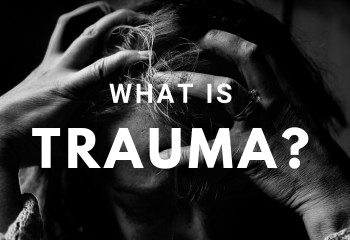
What is Trauma?
July 01, 2019
Trauma. Unfortunately, it is a word we hear often now in the news and media - trauma related to mass shootings, natural disasters, sexual assaults and bullying. But what is trauma? Definition of Trauma Direct...

A Story of Hope: Meet Donna
July 01, 2019
About a year ago, I unexpectedly had to go on short term disability when my mental health began to severely impact my day-to-day living. In my role as a prominent and well-respected Occupational Therapist, I...
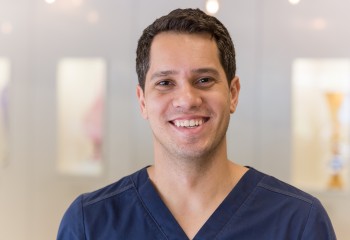
Faces of Hope: Daniel Oliveira, BSN, RN Nurse
June 07, 2019
When a client admits to HopeWay, the members of their treatment team are dedicated to equipping the client with the resources they need to achieve their clinical goals. As a key member of this team,...

Faces of Hope: Yvonne Carrasco, MSW, LCAS, MAC Primary Therapist
June 06, 2019
Faces of Hope: Getting to Know Members of HopeWay's Treatment Team Yvonne Carrasco, MSW, LCAS, MAC Primary Therapist When a client admits to HopeWay, the members of their treatment team are dedicated to equipping the...
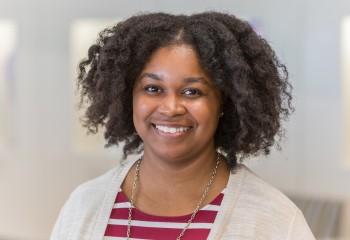
Postpartum Depression or Baby Blues? Self-Care Either Way!
April 30, 2019
Written by Dr. Taren Coley, MD, Psychiatrist - Director of Child & Adolescent Services The art of prioritizing and personalizing self-care is a learned behavior. Logically we know that it is important to take care...
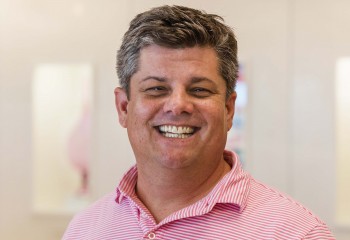
Dan Harris Helped Me Be Smarter About My Mental Health
March 11, 2019
Michael C. Hernandez, HopeWay Marketing and Social Media Near the end of 2018, I started seeing a new therapist. She taught me how to use the tools of cognitive behavioral therapy (CBT), and she was also...

Faces of Hope: Jason Peck, Psychiatrist and Sleep Medicine Consultant
March 04, 2019
In addition to conducting psychiatric consultations as one of HopeWay's psychiatrists, Dr. Peck's unique training in sleep medicine also allows him to help clients who are actively being treated for problems related to hypersomnia, insomnia,...
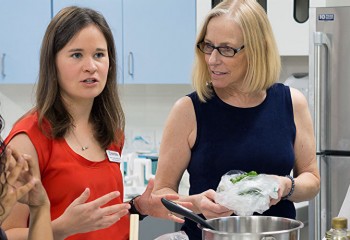
What's Your Relationship Status with Your Food?
February 14, 2019
Written by Ellen Jones, MS, RD, LDN & Sarah Craig Haverland, RD, LDN Thinking about updating the relationship status between your brain and what you put in your body? Though HopeWay doesn't treat primary eating disorders,...

HopeWay's First Two Years: A Reflection from our CEO and Chief Medical Officer
January 23, 2019
Alyson R. Kuroski-Mazzei, DO, DFAPA, FASAM I’m still in awe at all we’ve built and accomplished at HopeWay in our first two years. It’s important that we pause early in this new year and reflect...

Rebecca: A Story of Transformation
January 16, 2019
"HopeWay was the best gift I could have ever given myself. It has changed my life in countless ways and I am forever grateful." - Rebecca, former client As you've heard us say before,...

How To Prepare for Mental Health Treatment: A Conversation with an Admissions Specialist at HopeWay
October 25, 2018
By Morgan Liles, Director of Client Engagement You are finally ready to reach out for help dealing with the depression that has darkened your life for years. Or you are desperately seeking help for a...

Why HopeWay?
September 24, 2018
Thanks to Simon Sinek’s enormously popular TED Talk, it has been increasingly common to ask people or organizations; “What’s Your Why?” Having recently read Sinek’s book, Start with Why, we started thinking about HopeWay’s purpose, cause...

A Story of Hope: Meet Justine
August 24, 2018
Wikipedia defines darkness as the partial or total absence of light. For someone like myself who is diagnosed with major depressive disorder, the meaning is strikingly different. It could be 75 degrees outside with the...
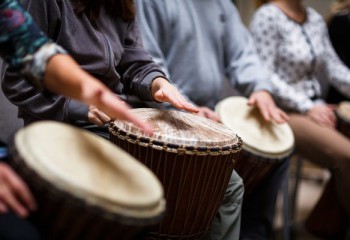
Drumming Down Stress & Anxiety
August 01, 2018
While walking around HopeWay's campus, you may hear the sounds of rhythmic bass echoing through the halls. What you've stumbled upon is one of the drumming workshops led by our pastoral care counselor, JD McNutt....

Horticultural Therapy Program Profile
January 31, 2018
Our horticultural therapist, Bobbie Mabe, was featured in the 2018 winter newsletter, Horticultural Therapy Institute. Here is a sample of the article: Horticultural Therapy has been a part of therapeutic programming at HopeWay since its...
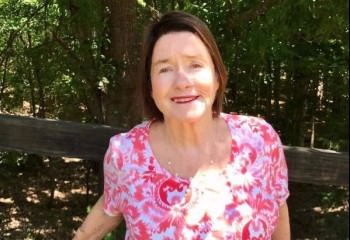
A Story of Hope: Meet Mary Anne
June 29, 2017
I'm 69 years old and have suffered from depression and bipolar disorder for the last 40 years. I've had many ups and downs with my health and my family and have probably been in 10...
